|
|
||||||
|
Published by : PROFESSIONAL MEDICAL PUBLICATIONS |
||||||
|
ISSN 1681-715X |
||||||
|
||||||
|
- |
||||||
|
ORIGINAL ARTICLE |
||||||
|
- |
||||||
|
Volume 25 |
October - December 2009 (Part-I) |
Number 5 |
||||
|
|
||||||
|
||||||
|
|
||||||
|
Published by : PROFESSIONAL MEDICAL PUBLICATIONS |
||||||
|
ISSN 1681-715X |
||||||
|
||||||
|
- |
||||||
|
ORIGINAL ARTICLE |
||||||
|
- |
||||||
|
Volume 25 |
October - December 2009 (Part-I) |
Number 5 |
||||
|
|
||||||
|
||||||
Frequency of cardiac defects among children at
echocardiography centre in a teaching hospital
A. Salam Malik1, Rukhsana Majeed2, M. Saleem Channer3, M. Imran Saleem4
ABSTRACT
Objective: To assess frequency of cardiac defects among children from birth to 12 years of age on echocardiography basis.
Methodology: A cross sectional study was conducted at echocardiography centre in coronary care unit at Bahawal Victoria Hospital Bahawalpur for fifteen months from April 2007 to July 2008. A sample of 150 patients (<12 years age) were selected by non-probability convenience sampling technique. The cardiologists performed echocardiography by Paediatric Transthoracic echo probe; 2-D colour Doppler, Acuson CV-70 & Niemo-30 echocardiography machines. Mothers of children with cardiac defects were interviewed at the echocardiography centre. Variables included were A- Muscular plus Vascular defects; B- Valvular defects; C-Pericardial effusion; D- Dextrocardia and E- Congestive cardiac failure. History of children for sore throat followed by joint pains; history of mothers for drug intake (antihypertensive, antipyretic, anti-emetic, hypoglycaemic) as well as chronic diseases (diabetes mellitus, hypertension, anaemia) during pregnancy were surveyed. Parity of mothers, their cousin marriages, and family socio-economic status was also inquired. The results were tabulated, analyzed and finally subjected to suitable test of significant (SR of proportion) to find out statistical significant if any.
Results: It was found that out of 150 patients, 76 (50.66%) were suffering from Cardiac muscular and Vascular defects, 61 (40.66%) Valvular defects, 7 (4.66%) Pericardial effusion, 2 (1.33%) Dextrocardia and 4 (2.66%) from Congestive Cardiac Failure. According to age, 54 (36%) were from birth to 3 years of age and 51 (34%) from 10 to 12 years. There was history of Rheumatic fever among 45 (30%) children. There were 106 (70.6%) children from lower socio-economic class and 79 (52.6%) parents had history of cousin marriages.
Conclusion: Frequency of cardiac defects was more in children of male sex, lower socio-economic group, from birth to three years age and children from primipara mothers in our specified locality. Rheumatic fever, cousin’s marriage, and prescribed drugs intake during pregnancy (for metabolic and hormonal disorders) were other contributors to cardiac defects.
KEYWORDS:
Cardiomyopathy, Tetralogy of Fallot, Ventricular Septal Defect, Pericardial Effusion, Dextrocardia, Echocardiography.Pak J Med Sci October - December 2009 (Part-I) Vol. 25 No. 5 712-717
How to cite this article:
Malik AS, Majeed R, Channer MS, Saleem MI. Frequency of cardiac defects among children at echocardiography centre in a teaching hospital. Pak J Med Sci 2009;25(5):712-717.
1. Dr. Abdul Salam Malik,
MBBS, DCH, FCPS.
Assistant Prof Community Medicine,
Quaid-e-Azam Medical College Bahawalpur.
2. Dr. Rukhsana Majeed,
MBBS, MCPS, FCPS, MBA,
DCPS-HPE, Prof & Head of
Community Medicine Department,
Bolan Medical College, Quetta
3. Dr. Mohammad Saleem Channer,
MBBS, DCH, MCPS,
Assistant Prof Community Medicine,
Quaid-E-Azam Medical College Bahawalpur
4. Dr. Muhammad Imran Sale MBBS,
Al-Shifa Trust Eye Hospital,
Rawalpindi - Pakistan.
Correspondence:
Dr. Abdul Salam Malik,
52-B, B.V. Hospital Medical Colony,
Bahawalpur – Pakistan.
E-mail: salammalik62@hotmail.com
* Received for Publication: December 11, 2008
* Revision Received: October 8, 2009
* Revision Accepted: October 9, 2009
INTRODUCTION
The ante-natal blood circulation pattern some times persists in certain forms due to congenital cardio vascular defects. Certain autoimmune diseases and rheumatic carditis affect the cardiac structure and haemodynamic circulatory functions. However, congenital defects are underestimated due to home deliveries and quick discharge of mother with her neonate from hospital deliveries. Later on, these children are detected upon referral to echocardiography due to cyanosis, clubbing or cardiac murmurs. Therefore, number of congenital heart disease patients are increasing due to new entries and their survival for long time.
1Patients with right to left shunt were labelled as cases of "cyanotic heart disease" whether or not cyanosis was recognized clinically. Similarly, those with left to right shunt were labelled as "acyanotic heart disease" patients even if cyanosis was due to certain other reasons. Diabetes Mellitus, Alcohol, progesterone, certain viruses and other teratogens are believed to be associated with congenital cardiac defects along with chromosomal abnormalities or gene mutations. However, the rheumatic fever appears to be the commonest acquired factor for valvular cardiac lesions. Cardiac defects may be valvular (stenosis or regurgitation), muscular (structure or motion) or pericardial (inflammation or fluid collection) which can be detected by transthoracic or transoesophageal echocard-iography.
2 The transoesophagus echocardio-graphy adds further knowledge when unusual presentation of cardiac tumour is there.3Patients with aneurysm require urgent aneurysmectomy when detected by echocardiography.
4 Patients with very low birth weight along with those in neonatal intensive care unit with cardiac disease are given particular attention for their follow up.5The objective of this study was to assess frequency and distribution of cardiac defects among children with the help of echocardiography.
METHODOLOGY
This cross sectional study was conducted at echocardiography centre in coronary care unit at Bahawal Victoria Hospital Bahawalpur for fifteen months from April 2007 to July 2008. Workload in Paediatric OPD was 73251 patients, indoor admitted were 16901 and 723 patients underwent echocardiography during this period. A sample of 150 patients were selected by non-probability convenience sampling technique from children less than 12 years of age referred to echocardiography centre.
The cardiologists posted at the centre performed echocardiography. There were two echocardiography machines, Acuson CV-70 and Niemo-30. Both were 2-D; continuous wave colour Doppler, M-mode with adult plus Paediatric Transthorasic echo probe facility.
Children’s mothers were interviewed at the echocardiography centre immediately after receiving echo report indicating cardiac defects. Children declared normal on echo report were excluded.
Variables included for specific cardiac defects in this study were classified and divided into groups as; A- Muscular plus Vascular defects; B- Valvular defects; C- Pericardial effusion; D- Dextrocardia and E- Congestive cardiac failure. In addition, history of children for sore throat followed by joint pains; history of mothers for drug intake (antihypertensive, antipyretic, anti-emetic, hypoglycaemic) as well as chronic diseases (diabetes mellitus, hypertension, anaemia) during pregnancy were asked. Parity of mothers, their cousin marriages, and family socio-economic status were also inquired. The data was collected with the help of predesigned questionnaire (Annexure-I). The results were tabulated, analyzed and finally subjected to suitable test of significant (SR of proportion) to find out the statistical significant if any.
RESULTS
Total number of 150 children with cardiac defects was studied. The cardio-vascular defects were categorized as:
Group-A: It consisted of 76 (50.66%) patients suffering from muscular and vascular defects of heart. Further stratification revealed that Tetralogy of Fallot (TOF) was found in 19 (25%) patients, ventricular septal defects (VSD) in 21 (27.63%), atrial septal defects (ASD) in 6 (7.89%), patent ductus arteriosis (PDA) in 12 (15.78%) and cardiomyopathy was found in 18 (23.68%) patients as shown in Table-I.
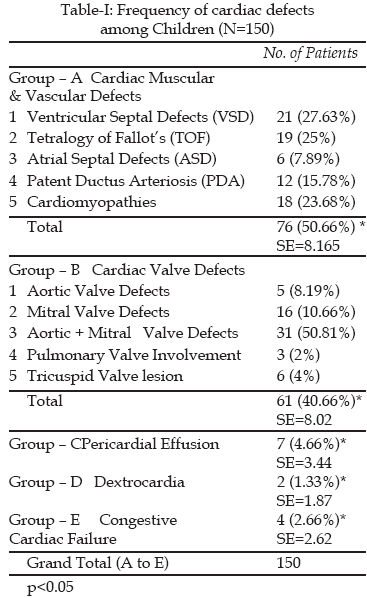
Group-B: It comprised of 61 (40.66%) children having valvular heart defects. Further stratification of this group revealed that aortic valve defect was found in 5 (8.19%) children, mitral valve defect in 16 (10.66%), combined Aortic and Mitral valvular lesion in 31 (50.81%), Pulmonary valve defect in 3 (2%) and Tricuspid valve defect in 6 (4%) patients.
Group-C: It included Pericardial Effusion patients, they were 7 (4.66%) in number.
Group-D: It consisted of Dextrocardia patients. They were 2 (1.33%) in number.
There were only 4 (2.66%) patients in Group-E having Congestive Cardiac Failure (CCF). Age distribution was noted and it was found that there were 54 (36%) patients having ages from birth to three years, 15 (10%) from 4 to 6 years, 30 (20 %) from 7 to 9 years and 51 (34%) from 10 to 12 years of age. (Table-II)
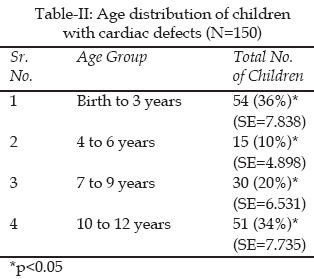
The gender difference was also noted and it was found that 90 (60%) were male and 60 (40%) were female. The history of Rheumatic fever was present in 45 (30%) patients. It was observed that 77 (51.33%) patients were from Primipara and 73(48.6%) from multipara mothers. (Table- III)
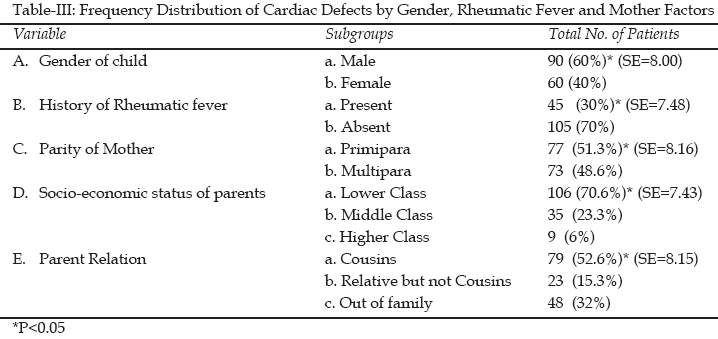
Regarding socio-economic status of parents, it was found that 106 (70.6%) patients belonged to lower socio-economic class, while 35 (23.3%) to middle class and only 9 (6%) to higher socio-economic class. Seventy nine (52.6%) parents had cousin marriages while 23 (15.3%) parents were close relatives but not cousins and 48 (32%) were married out of family.
The history of drugs intake during pregnancy revealed that 98 (65.33%) parents had a positive history but they could not recall type of drugs taken. Among those who recalled drugs intake during pregnancy, anti-hypertensives were taken by 19 (12.66%), anti-emetics by 11 (7.33%), anti-pyretics by 9 (6%) and analgesics by 13 (8.66%). (Table-IV)
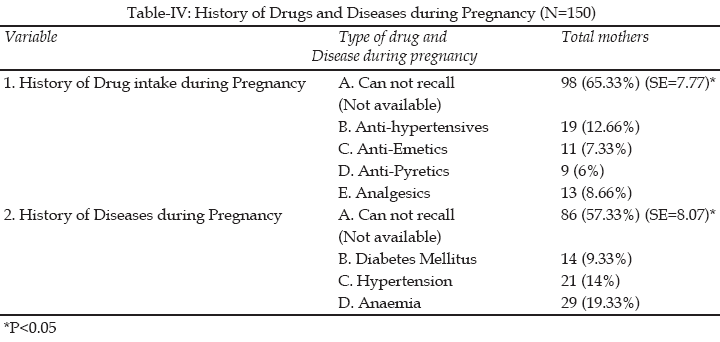
The history of chronic diseases during pregnancy was also taken. It was found that 86 (57.33%) parents of affected children could not recall their diseases during pregnancy. While 29 (9.33%) mothers were diabetics, 21 (14 %) hypertensives and 29 (19.33%) mothers gave a positive history suggestive of Anaemia.
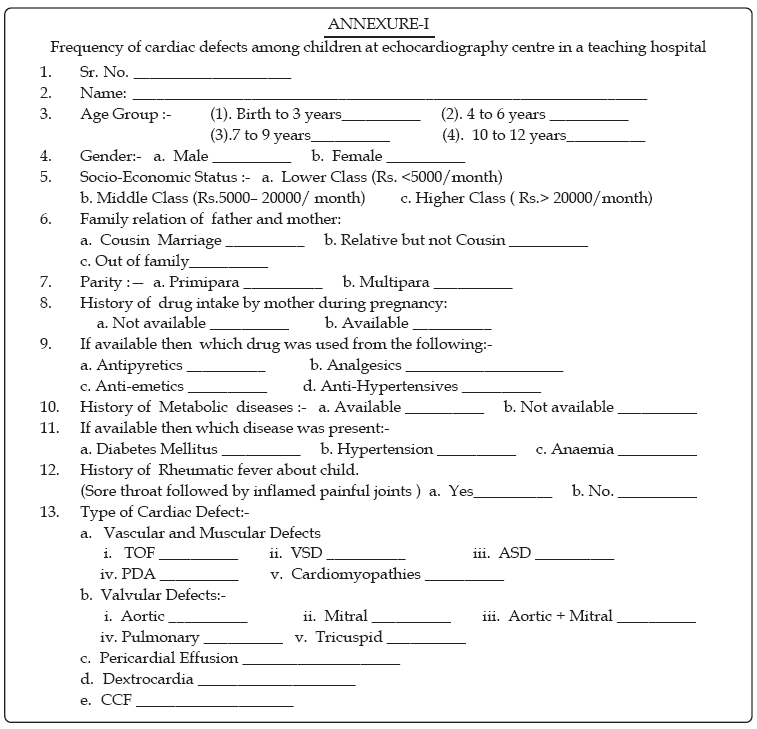
DISCUSSION
We have found in our study that cardiac defects were more common in the children of primipara mothers as compared to multipara ones. There were 51.3% children having cardiac defects born to primipara. This finding is similar to that made by Parween F and Twab S
6. However, the cousin marriages were found among 52.6% of our study population parents as compared to 44.74% consanguineous marriages found in the study quoted above.We have found VSD (27.63%) and TOF (25%) to be the commonest acyanotic and cyanotic heart diseases respectively. These findings are in line with those reported previously.
7,8 Majority (60%) of our study children were males. This finding is the same as already reported in previously done study.9 But it is contradictory to the finding made by Burki MK and Babar GS10 who reported both sexes to be equally affected. This difference may be due to a number of factors such as socio-economic, cultural, ecological and genetic factors.It was noted in our study that history of Rheumatic fever was present among 30% children which is higher than 17.14% as described by Ejaz MS and Billoo AG.
11 This difference may be attributed to low socio-economic condition prevailing in our area. Similarly, we have found more cardiac defects in two age group patients; those from birth to three years and another upsurge in age group ranging from 10 to 12 years. This type of bimodality has also been reported in another study.11It has been found that majority of women (65.33%) in our study could not recall use of any drug during pregnancy. Just 7.33% in our study told that they used anti-emetics and 8.66% used analgesics during pregnancy. These percentages are less than those worked out by Rizka MA and Abdel-Aziz F.
12 This difference may be due to the fact that in our area, the patients are reluctant to take allopathic medicines as these are thought by them to be "HOT" medicines.CONCLUSION
Frequency of cardiac defects was more in children of male sex, lower socio-economic group, from birth to three years age and children from primipara mothers in this specified locality of study. The acquired conditions like rheumatic fever, cousin’s marriage, and drugs intake during pregnancy (for metabolic and hormonal diseases) were other contributors to cardiac defects in our study population.
RECOMMENDATIONS
On the basis of above findings, the following recommendations are made:-
1. Creation of awareness about cardiac problems among general public through mass media.
2. Improvement of literacy rate.
3. Poverty alleviation measures.
4. Improvement of quality of life.
5. Echocardiography machine and echo training of medical personnel working in paediatric units are necessary managerial steps for routine echo examination of children to detect and manage cardiac defects at very early stage.
REFERENCES
1. Ferencz C, Rubin JD, Meconter SDJ. Congenital Heart Diseases. Prevalence at live birth. The Baltimore Washington infant study Am J Epidemiol 1985;121(31).
2. Eltzscghg HK, Kallmeyer IJ, Mlhaijevic T. A practical approach to a comprehensive epicardial & epiaortic echocardiographic examination. J Cardiothorac. Vase-Anesth 2003;17(4):422-9.
3. Plana JC, Iskandar SS, Ostrowski ML. Cardiac angiosarcoma an unusual presentation simulating mitral stenosis & constructive-effusive pericarditis. J Am Soc Echocardiogr 2003;16(12):1331-3.
4. Bunch TJ, Oh JK, Click RL. Sub epicardial Aneurysm of the left ventrical. J Am Soc Echocardiogr 2003;16:1318- 21.
5. Larson C, Hermos R, Delaney A, Daly D, Mitchell M. Risk factor associated with delayed thyrotropin elevation in congenital hypothyroidism. J Pediar 2003;143(5):587-91.
6. Perveen F, Twab S. Frequency and pattern of distribution of congenital anomalies in the newborn and associated maternal risk factors. J Coll Physicians Surg Pak 2007;17(6):340-3.
7. Sadiq M, Roshan B, Khan A, Latif F, Bashir I, Sheikh SA. Pattern of Paediatric Heart diseases in Pakistan. J Coll Physicians Surg Pak 2002;12(3):149-53.
8. Rahim F, Younas M, Gandapur AJ, Talat A. Pattern of Congenital Heart Diseases in children at tertiary care center in Peshawar. Pak J Med Sci 2003;19(1):19-22.
9. Sadiq M, Roshan B, Khan A, Larif F, Bashir I, Sheikh SA, Pediatric Heart Disease in Pakistan – epidemiological data on 6620 patients. Pak Paed J 2001;25(2):63-70.
10. Burki MK, Babar GS. Prevalence and Pattern of Congenital Heart Diseases in Hazara. J Ayub Med Coll 2001;13(4):16-8.
11. Ejaz MS, Billoo AG. Clinical Pattern of Heart Diseases in children. J Coll Physicians Surg Pak 2000;10(1):10-2.
12. Rizk MA, Abdel-Aziz F, Ashmawy AA, Mahmoud AA, Abuzeid TM. Knowledge and practices of pregnant women in relation to the intake of drugs during pregnancy. J Egypt Public Health Assoc 1993;68(5-6):567-91.
HOME | SEARCH | CURRENT ISSUE | PAST ISSUES
Professional
Medical Publications
Room No. 522, 5th Floor, Panorama Centre
Building No. 2, P.O. Box 8766, Saddar, Karachi - Pakistan.
Phones : 5688791, 5689285 Fax : 5689860
pjms@pjms.com.pk